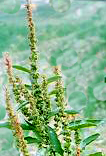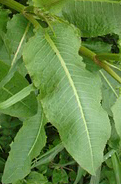 I admit up front that I have never deliberately grown dock. I have never had to because it has been a weed everywhere I have wanted some…and yes, it is an outstanding plant in at least one way. When in flower (about early June where I live) it bears spikes of small green flowers that look fabulous in flower arrangements. I once used some stems in wedding arrangements and the customer loved them. Little did anyone know that I had cut them in a vacant lot along a main thoroughfare in Annapolis. Later in the season the seeds become reddish brown and look good in dried arrangements. I can not honestly rave about the leaves, however, as they are very coarse and a bit too floppy for my taste. But I never rule anything out and one day the wavy margins of the leaves and their strong green color may be the perfect foil for some flower I want to use to get a certain look. Dock might make a decent garden plant but why bother growing it when it is so ubiquitous? Besides, it is difficult to eliminate once you have some because it has a very long taproot (up to 5’) and its abundant winged seeds are adapted to be carried by wind, water and animals, and can remain viable in the soil for up to 50 years. The milk in the plant contains a substance that can cause mild dermatitis so wear gloves when you handle it.
I admit up front that I have never deliberately grown dock. I have never had to because it has been a weed everywhere I have wanted some…and yes, it is an outstanding plant in at least one way. When in flower (about early June where I live) it bears spikes of small green flowers that look fabulous in flower arrangements. I once used some stems in wedding arrangements and the customer loved them. Little did anyone know that I had cut them in a vacant lot along a main thoroughfare in Annapolis. Later in the season the seeds become reddish brown and look good in dried arrangements. I can not honestly rave about the leaves, however, as they are very coarse and a bit too floppy for my taste. But I never rule anything out and one day the wavy margins of the leaves and their strong green color may be the perfect foil for some flower I want to use to get a certain look. Dock might make a decent garden plant but why bother growing it when it is so ubiquitous? Besides, it is difficult to eliminate once you have some because it has a very long taproot (up to 5’) and its abundant winged seeds are adapted to be carried by wind, water and animals, and can remain viable in the soil for up to 50 years. The milk in the plant contains a substance that can cause mild dermatitis so wear gloves when you handle it.
Type: Perennial weed.
Bloom: Small green flowers are borne in dense racemes June though September. Reddish brown seeds and red stems add to the attractiveness of the plant.
 Foliage: Large (to 12”), lanceolate, rich green leaves with wavy margins.
Foliage: Large (to 12”), lanceolate, rich green leaves with wavy margins.
Size: 18” H x 12’ W.
Light: Full sun.
Soil: Tolerant of a wide variety of soils but prefers moist ones.
Hardiness: Zones 4-9.
Care: Dock does not do well when crowded or when disturbed.
Pests and Diseases: None of significance.
Propagation: Seed in spring.
